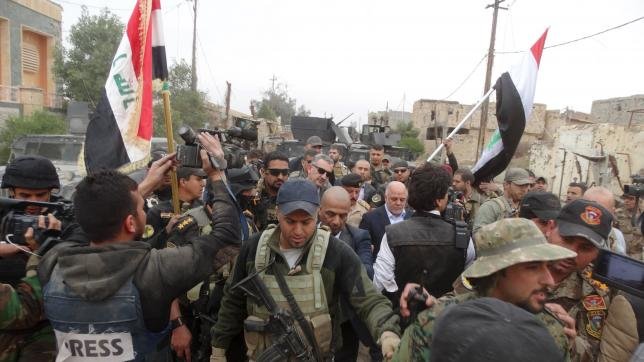The same phenomenon of "ISIS evaporation" was registered in Sinjar when 7500 Kurds, supported by the U.S Air Force, occupied the key northern Iraqi city, finding a very small number of ISIS fighters in it.
So where did all these ISIS fighters go to?
A high-ranking source within the Iraqi government told me:
"The US forces operating in Iraq within the military operation room in Baghdad are the ones who define the units and the time (day and hour) of attacks against ISIS. If we want to benefit from an Air Force to defeat the terrorist group, we should bow to the American command. It is not unlikely for a possible American - Turkish coordination to communicate with "ISIS" and give a free way out to fighters to withdraw in the direction of the Syrian - Iraqi borders. That's the information our drones collected in the last few days prior the attack of Ramadi.
"Our signals and Human Intelligence informed the Americans and us about ISIS movement of troops. We were not allowed to engage against these and no one in the government can contradict the Americans for the moment. The U.S ordered Baghdad to keep al-Hashd al-Sha'bi (PMUs) away from the battlefield of Anbar perhaps to ensure a free passage to ISIS and to reduce the Iranian influence and credit of victories in Iraq.
"America has asked decision makers in Baghdad to change the heads of anti-terrorism, intelligence and security services of the army and Interior Ministry. Moreover, the Secretary General of the Council of Minister was also suggested by the Americans and in consequences he has been appointed to this position. The U.S wants a homogeneous team that is friendly to its policy and presence of these (US forces) on the ground in Iraq.
"The hostile era - created by the former Prime Minister Nuri al-Maliki that led to a withdrawal of the forces from Mesopotamia - is over and the policy adopted at the moment consists of reducing the influence of the Iranian Revolutionary Guard Corps (IRGC) and Maj. Gen. Qassem Soleimani over a few Iraqi armed groups. What is contributing to the success of such a policy is the fact that the Prime Minister Haider al-Abadi is in a bad terms with Soleimani. Since the start, PM Abadi believed that Soleimani was planning to remove him from power, supporting al-Maliki and promoting other choices to replace the actual Premier", said the source.The source concluded:
"Iran controls various military organisations fighting within the Popular Mobilisation Units that are strongly present in the battlefield in Iraq and in Syria. Such an influence persuaded al-Abadi to choose the path that leads to 'Uncle Sam' instead of choosing the one of Welayat-el-faqih. This is why Abadi rejected, following an explicit American demand, any Russia military assistance in the air, in Iraq, unlike the Syrian President Bashar al-Assad. The Iraqi Prime Minister is aware of the possibility that the U.S would like to see 3 Iraqi cantons, one for the Kurds, one for the Sunni and another one for the Shia. The Americans are also supporting the Turkish presence in Iraq, and met with the Director of the French Intelligence Service who said: The Middle East will never be the same as before. What is becoming more clear now that ISIS is a toy used by players for their agenda and plans to reshuffle the map of the Middle East".Source: Al-Rai Media
Translated by Elijah J. Magnier
Edited by Ollie Richardson




Comment: Further reading: